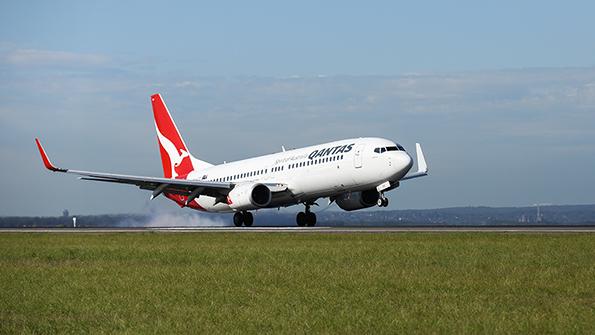ANALYSIS: Domestic Markets Will Be Mainstay For Australasian Carriers

Australasian airlines have grounded almost all of their widebodies in response to the bleak outlook for long-haul travel, although some carriers also see opportunities for new aircraft types in the post-pandemic industry environment.
Domestic routes have become the mainstay for airlines in the region. After the initial closures, Australia saw the beginnings of a domestic capacity rebound before a second wave of COVID-19 cases—particularly in Victoria—stalled the recovery in July.
Australian states imposed domestic border restrictions, which caused interstate travel to almost grind to a halt. But new case numbers have declined again, prompting many states to begin the process of reopening domestic borders. Domestic travel should continue to gain momentum as restrictions ease.
New Zealand domestic capacity has bounced back much more strongly, aside from temporary reversals in the important Auckland market. This reflects New Zealand’s relative success in controlling coronavirus outbreaks.
International travel remains heavily restricted for both markets, with services still at very low levels. There are some positive signs, however. Australia is allowing travelers from New Zealand to enter without quarantine, and while New Zealand has yet to reciprocate, it is considering such a step. Travel bubbles with certain Southeast Asian nations may be next to emerge.
Qantas, the region’s largest player, has said it does not expect to resume any substantial level of international flying until at least July 2021. This has prompted the carrier to park its widebodies, with its 12 Airbus A380s in storage for at least three years. Qantas is assuming that when long-haul international flights do resume, it will initially use its Boeing 787s.
The carrier generated headlines before the pandemic with its “Project Sunrise” plan to launch ultra-long-haul flights from Australia’s east coast to London or New York. It was just weeks away from confirming an order for Airbus A350-1000s for these flights when COVID forced the plan’s postponement. Qantas CEO Alan Joyce said the airline still plans to order the A350s when its financial situation and balance sheet have sufficiently recovered, as he believes the business case for the Sunrise flights has not disappeared. The airline also intends to place narrowbody replacement orders during the next few years, taking advantage of what should be a buyers’ market.
Meanwhile, cost-saving efforts are still underway. Qantas is undertaking a review of whether it should relocate its corporate headquarters, main MRO base and other facilities elsewhere in Australia. It is inviting states to submit incentive proposals. The carrier is also reviewing a plan to outsource its ground handling operations.
One of the most significant developments in the region has been Virgin Australia’s restructuring under voluntary administration. Virgin will come out of this process as a smaller airline, focused on domestic and short-haul international services. The carrier’s changes will shift the competitive dynamic in the Australian market as demand returns. The company will also have a new CEO with former Jetstar CEO Jayne Hrdlicka taking over from Paul Scurrah.
Virgin has phased out its widebody fleet of Airbus A330s and Boeing 777s during restructuring, meaning that for the medium term its international flying will be short haul, using its narrowbody fleet. However, the airline has also indicated it is considering placing orders for an eventual return to long-haul flying.
The airline intends to cut its fleet to 56 Boeing 737s, which would be almost 30 fewer than its pre-pandemic level. One question that must still be resolved is what happens with Virgin’s 48 737 MAX orders. The carrier is in negotiations with Boeing and is expected to issue an update soon. Deferrals or order cuts are possibilities, and Virgin may also consider switching some of the MAX orders to 787s.
Rex expansion
Another development is the emergence of a new player on domestic trunk routes, as Regional Express Holdings (Rex) plans to introduce a fleet of Boeing 737s for this purpose. It has reached a deal to lease six 737s to serve the Sydney-Melbourne-Brisbane triangle, and intends to build up to 10 aircraft. Rex plans to begin on March 1 with the Sydney-Melbourne route, which was one of the world’s busiest domestic routes before COVID. This is a big move for Rex, which until now has operated turboprops on regional routes, and is based on recognizing an opportunity with the two major players in the domestic market in a weakened condition.
Australia’s Alliance Air is also branching into a new fleet type. The carrier is buying 14 Embraer E190s from US company Azorra Aviation, which were formerly operated by Panama’s Copa Airlines. The E190 deliveries began in September and are scheduled to run over eight months. Alliance notes it is a good time to buy aircraft and the Embraers will be the right size to serve some mainline routes where there is decreased demand.
Air New Zealand
Air New Zealand is projecting that its long-haul flights will not return until its next fiscal year, which begins in July. With this in mind, the carrier intends to put its Boeing 777-300ERs into storage until at least September 2021. The airline has also put its 777-200ERs into storage, and these are unlikely to return to service with Air New Zealand. The -200ERs are older and were already scheduled to be phased out from 2022.
The only widebodies flying for Air New Zealand in the near future will be its 787-9s, which are flying cargo services and the carrier’s few international passenger flights. Like Qantas, Air New Zealand will initially use its 787 fleet for any additional international services that may resume.
The carrier has deferred some of its aircraft orders because of the pandemic, but is still on course to begin receiving its first 787-10 deliveries in its 2022/23 fiscal year. These aircraft were originally intended to replace the -200ERs as they retired.
Air New Zealand and Qantas both need the eventual return of their US routes to progress toward a full recovery of international operations. However, a resumption of two-way New Zealand-Australia flights would be a significant step in the meantime. New Zealand is the leading outbound market for Australian travelers, and also represents Australia’s second-largest source of inbound visitors after China.


